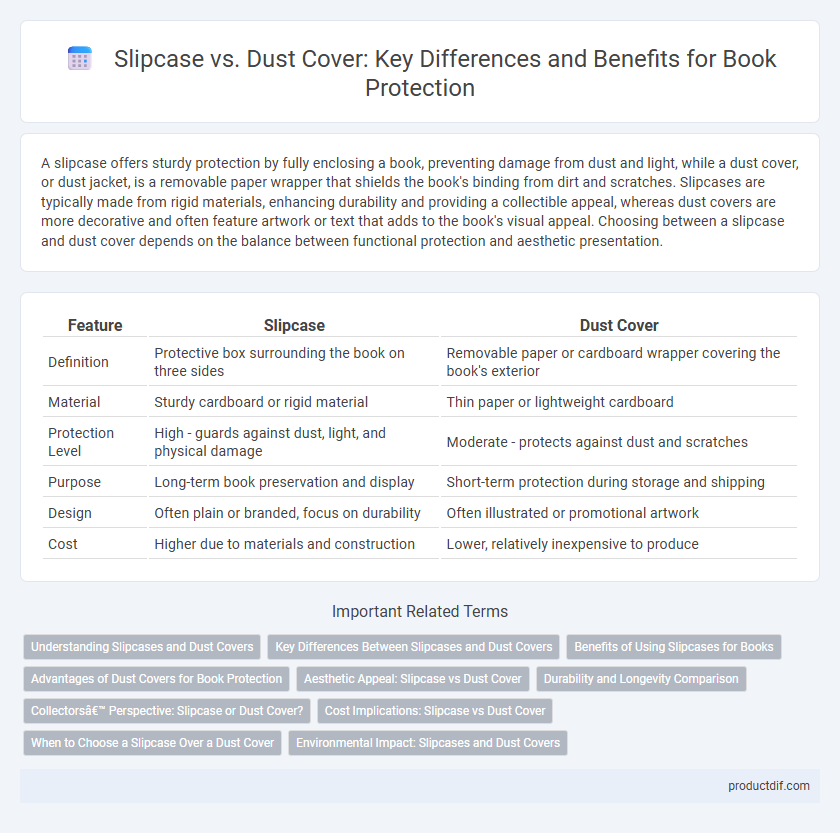A slipcase offers sturdy protection by fully enclosing a book, preventing damage from dust and light, while a dust cover, or dust jacket, is a removable paper wrapper that shields the book's binding from dirt and scratches. Slipcases are typically made from rigid materials, enhancing durability and providing a collectible appeal, whereas dust covers are more decorative and often feature artwork or text that adds to the book's visual appeal. Choosing between a slipcase and dust cover depends on the balance between functional protection and aesthetic presentation.
Table of Comparison
| Feature | Slipcase | Dust Cover |
|---|---|---|
| Definition | Protective box surrounding the book on three sides | Removable paper or cardboard wrapper covering the book's exterior |
| Material | Sturdy cardboard or rigid material | Thin paper or lightweight cardboard |
| Protection Level | High - guards against dust, light, and physical damage | Moderate - protects against dust and scratches |
| Purpose | Long-term book preservation and display | Short-term protection during storage and shipping |
| Design | Often plain or branded, focus on durability | Often illustrated or promotional artwork |
| Cost | Higher due to materials and construction | Lower, relatively inexpensive to produce |
Understanding Slipcases and Dust Covers
Slipcases are rigid, often decorative boxes designed to encase a book entirely, providing robust protection against dust, light, and physical damage while enhancing aesthetic appeal. Dust covers, also known as dust jackets, are removable paper or plastic sleeves wrapped around a book's binding, primarily serving to protect against dust and minor wear while displaying artwork and information. Understanding the functional and visual differences between slipcases and dust covers helps collectors and readers select the appropriate protective accessory for their books.
Key Differences Between Slipcases and Dust Covers
Slipcases provide rigid, protective enclosures that fully encase a book, shielding it from physical damage and dust, while dust covers are thin paper or cardboard jackets designed primarily to protect the book's binding from dirt and minor wear. Slipcases enhance durability and aesthetic appeal by often featuring matching designs and structural strength, whereas dust covers offer lightweight protection and can include additional artwork or text to attract readers. Key differences include material thickness, level of protection, and their role in preserving collectible or special edition books.
Benefits of Using Slipcases for Books
Slipcases provide superior protection by encasing books completely, shielding them from dust, light, and physical damage, which significantly extends the lifespan of valuable editions. Their rigid structure offers better support during storage and display, preventing bending or warping of book covers and pages. Collectors often prefer slipcases as they enhance aesthetic appeal while preserving the book's condition, making them ideal for limited editions and award-winning publications.
Advantages of Dust Covers for Book Protection
Dust covers provide superior protection against dust, moisture, and sunlight, significantly prolonging the lifespan of a book's cover and pages. Their lightweight, flexible design absorbs shocks and prevents surface wear, enhancing the book's durability during handling and storage. Unlike slipcases, dust covers allow easy access without removing the entire protective layer, making them ideal for frequent readers while maintaining aesthetic appeal.
Aesthetic Appeal: Slipcase vs Dust Cover
Slipcases offer a sleek, minimalist aesthetic that enhances the visual appeal of a book by enclosing it entirely, creating a unified and premium look often favored by collectors. Dust covers provide vibrant artistry and detailed imagery directly on the jacket, adding character and visual interest while also serving as a protective layer. Both add distinct aesthetic value: slipcases emphasize elegance and durability, whereas dust covers highlight creative expression and intricate design.
Durability and Longevity Comparison
Slipcases offer superior durability compared to dust covers by providing a rigid protective box that safeguards books from physical damage, dust, and light exposure over time. Dust covers, typically made of paper or thin cardboard, are more susceptible to tears, fading, and wear, making them less effective for long-term preservation. For collectors and archival purposes, slipcases ensure enhanced longevity by maintaining the book's condition significantly better than standard dust jackets.
Collectors’ Perspective: Slipcase or Dust Cover?
Collectors value slipcases for their durability and ability to protect books from dust, light, and physical damage while maintaining the book's aesthetic appeal. Dust covers, often crafted from lightweight paper or cardboard, provide visual allure and preserve the book's condition but are more susceptible to wear over time. For collectors aiming to preserve the book's value and condition, slipcases generally offer superior protective benefits compared to dust covers.
Cost Implications: Slipcase vs Dust Cover
Slipcases generally cost more to produce than dust covers due to the additional materials and construction required for their rigid, protective design. Dust covers are typically made from thinner, printed paper or cardstock, making them more affordable but less durable than slipcases. For publishers and collectors, slipcases offer better longevity and premium presentation at a higher upfront expense, while dust covers provide economical protection with lower production costs.
When to Choose a Slipcase Over a Dust Cover
Choose a slipcase over a dust cover when seeking enhanced protection for valuable or collectible books, as slipcases fully encase the book and guard against dust, light, and physical damage. Slipcases are ideal for limited editions, art books, or large volumes that require sturdy support and long-term preservation. Dust covers are more suitable for everyday use, offering ease of access but less comprehensive protection compared to slipcases.
Environmental Impact: Slipcases and Dust Covers
Slipcases are typically made from sturdy cardboard or heavy-duty paperboard, often making them more recyclable and durable compared to dust covers, which are usually crafted from thinner paper or plastic-coated materials that can hinder recycling processes. Dust covers, especially those with plastic lamination, contribute more to environmental waste due to lower biodegradability and increased resource consumption during manufacturing. Choosing slipcases over dust covers reduces the environmental footprint by promoting longevity and facilitating more sustainable disposal options.
Slipcase vs Dust Cover Infographic

 productdif.com
productdif.com